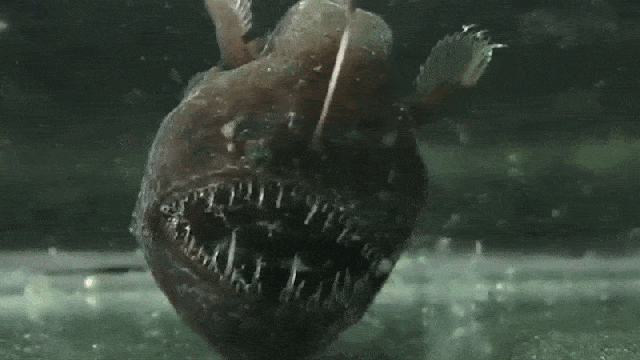The depths of the ocean are festooned with the most nightmarish creatures imaginable. You might think you’re safe, because these critters live thousands of metres down in a cold dark abyss, but the vampire squid, which looks like a nightmare umbrella, and the frilled shark — a literal living fossil — will live on in the recesses of your mind long after you’ve clicked away. Enjoy these deep sea horrors and try to have a relaxing day afterwards.
Gif source: YouTube
10) Goblin shark
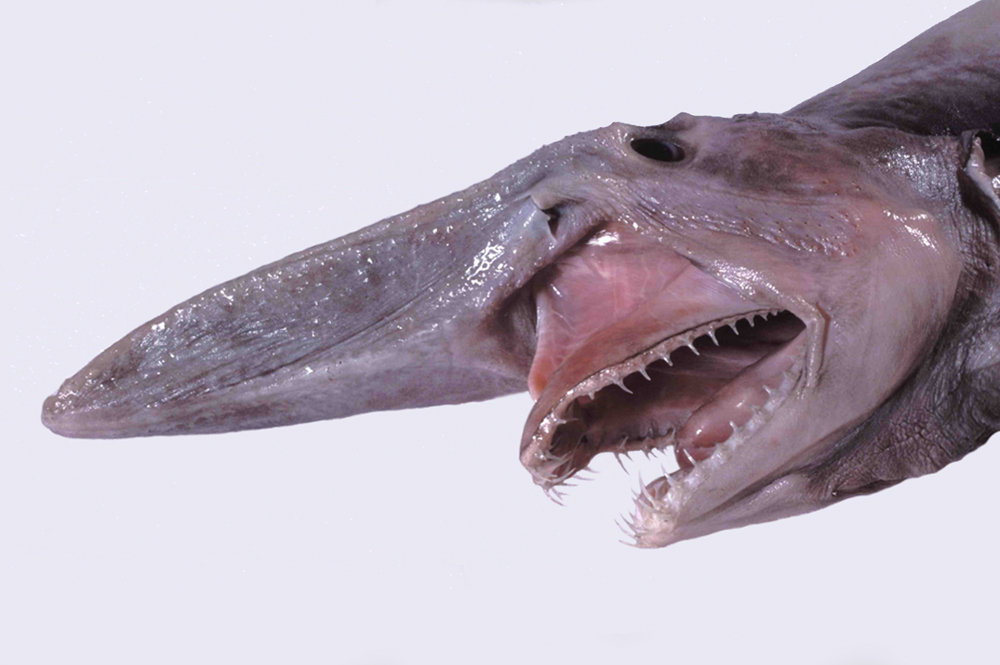
Image: Wikimedia Commons
Scientific name: Mitsukurina owstoni
Habitat: The goblin shark has been seen off the coast of Mississippi, Australia and more, and can live as deep as 1300m.
Lifestyle: Look at this creature’s ugly mug and tell me it isn’t out for blood. The goblin shark is clearly a predator, but other than that, we’re pretty much in the dark on its lifestyle. “They’re a species we don’t know much about at all,” Christopher Bird, a PhD Student in deep sea Shark ecology at the University of Southampton, told Gizmodo. “They have been found around the globe in rare cases. But the reason they protrude their jaw out in the characteristic fashion is because they’re hunting fast-moving fish and crustaceans in the middle of the water column.”
Spooky fact(s): These bizarre beasts are known for their long, boopable snouts and ferocious nightmare teeth. Their skin is translucent, so that pink you see is actually a direct look at their insides.
9) Dumbo octopus
Scientific name: Grimpoteuthis (this is the genus name, there are 17 known species of Dumbo octopi).
Habitat: These silly guys, with their flappy little ears, can live at depths of 3000 to 4000m. According to Aquarium of the Pacific, Dumbo octopi have been found in many regions around the world, including the waters near Australia, California and Oregon.
Lifestyle: Dumbo octopi are foraging predators — according to Oceana, they skim the ocean floor and eat pelagic invertebrates like krill and jellyfish.
Spooky fact(s): Sure, they may look cute, but just imagine being swarmed by a bunch of these things. “Dumbo octopuses envelop their prey within their webbed arms to make a balloon around them, and then consume them,” Dr Nicholas Higgs, Deputy Director of the Plymouth University Marine Institute, told Gizmodo.
It’d be like getting smothered to death by a horde of kindergarteners. While the dumbo octopus is only 20cm tall, anything that eats primarily jellyfish is not to be trusted.
8) Giant isopod
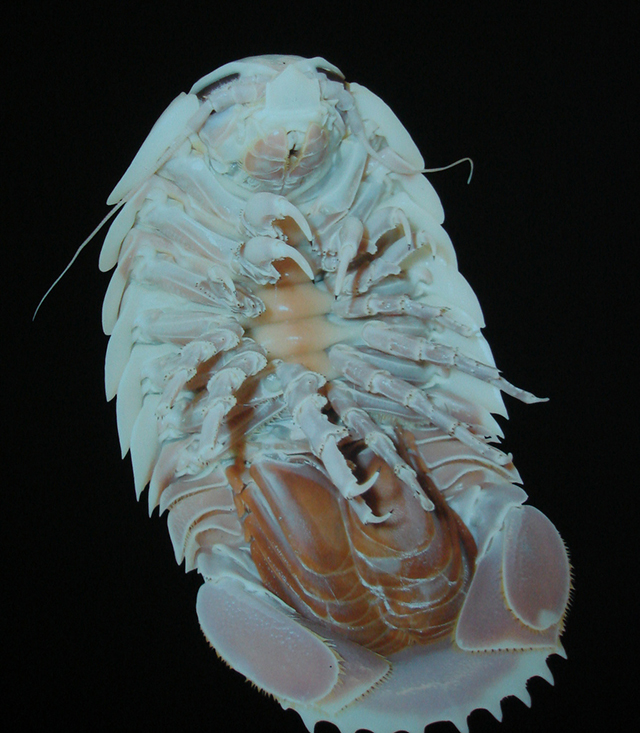
Photo: Tach_RedGold&Green/Flickr
Scientific name: Bathynomus giganteus
Habitat: Giant isopods have been found off the coast of the Yucatán Peninsula in México, at depths of 359-1050m. Hopefully we won’t find them anywhere else.
Lifestyle: These little monsters, which can grow to be anywhere from five to 35cm tall, are straight up scavengers. According to a 2003 paper published in Deep Sea Research Part I: Oceanographic Research Papers, giant isopods have no shame in feasting on squid and fish remains.
Spooky fact(s): Maybe what’s most unsettling about the giant isopod is that it can fast for up to five years. “Females that are brooding their young don’t eat, probably to avoid exposure to predation,” Higgs said. “These animals are scavengers and so they are exposed to other scavengers when feeding on dead carcasses. In order to protect their young and themselves while acting for their young they simply hide out in the mud.”
Honestly, I’m sure it has an important function in its ecosystem, but this overgrown cockroach-alien makes every cell in my body want to scream.
7) Angler fish
Scientific name: Lophiiformes (this is the order name, as there are over 200 species of anglerfish, according to NOAA).
Habitat: Per National Geographic, these grumpy fish live mainly in the Atlantic Ocean off the coast of Europe and Northwest Africa, anywhere from 1000 to 3000m below the surface.
Lifestyle: Predator, obviously.
Spooky fact(s): Anglerfish are spooky little bastards. They use their weird biological headlamp — which is attached to their face — in order to draw prey in.
“The headlamp appendage is a specialised tissue that, in deep-sea anglerfishes, contains bioluminescent bacteria that the fish uses as a lure to attract potential prey towards its mouth,” Higgs told Gizmodo.
6) Viperfish

Image: Wikimedia Commons
Scientific name: Chauliodus sloani
Habitat: Viperfish are found in tropical and temperate waters around the world and can live as deep as 2800m. Thankfully, you’ll never encounter one of these at the beach.
Lifestyle: Also obviously a predator. Look at that gnarly underbite!
Spooky fact(s): Viperfish are extremely elusive, but when these beasts reveal themselves, it’s always a bad time. The creatures have long fangs, which act like a trap. Unsuspecting fish wander into that mouth trap, and it’s game over.
“Larger specimens are believed to be exclusively piscivorous and may swallow fishes reaching 63% of their own body length,” a team of marine biologists wrote in a 2009 study about anglerfish teeth.
5) Ghost shark
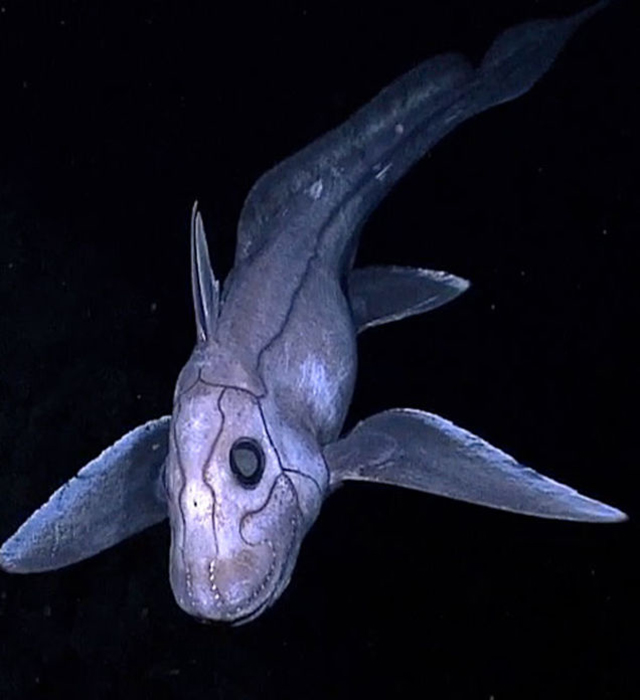
Image: Wikimedia Commons/NOAAS Okeanos Explorer
Scientific name: Chimaeras (family name)
Habitat: Sightings are rare, but chimaeras have been spotted off the coast of California and Hawaii. They can live at depths of 500 to 3000m.
Lifestyle: Ghost sharks are predators that mainly subsist on worms, crabs and molluscs. “You have different species at different depths,” Bird explained. “They’re absolutely bizarre creatures… they have got a rabbit-like jaw that helps them crush the shells on the sea floor.”
Spooky fact(s): I feel guilty including this one on the list, since it looks so miserable with its existence, but let’s be real — if you saw this swimming toward you in the ocean, would you greet it with open arms like Flipper? Like the frilled shark, chimaeras are living fossils, which means these dead-eyed creatures have changed very little over millions of years.
“They have really found there niche down there, which is eating stuff that nothing else can,” Bird explained. “They’re doing stuff that no other fish is doing, that no other shark is doing.”
4) Gulper eel
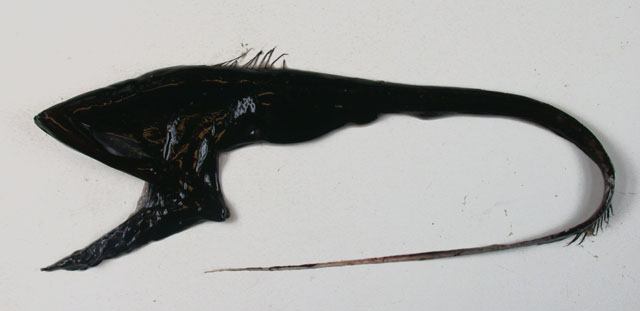
Image: Wikipedia
Scientific name: Eurypharynx pelecanoides
Habitat: The gulper eel can live at depths of 1000 to 2100m, and has been found in temperate and tropical regions throughout all oceans.
Lifestyle: This beast is a predator. It eats mainly crustaceans and fish.
Spooky fact(s): It’s pretty obvious why the Gulper eel is also known as the “pelican eel“: Its large jaw is very similar to that of the more pleasant looking bird’s. As Higgs explained, the gulper eel’s tremendous gape probably helps it swallow big meals — or do even stranger things.
“In gulper eels like Saccopharynx their strong jaws and large gape allow them to swallow extremely large prey,” Higgs said. “Others like the pelican eels (Eurypharynx) don’t have strong enough jaws to eat especially large prey. In this case it is thought that the the large gape unfolds like a huge parachute when within reach of the prey, engulfing the prey to prevent escape.”
Damn, what a way to go.
3) Vampire squid
Scientific name: Vampyroteuthis infernalis
Habitat: These little sea vampires lurk in both temperate and tropical zones, and can live at depths of 600 to 1200m.
Lifestyle: Vampire squid are detritivores. They eat lots of dead plankton, which feels very on-brand. “Vampire squid actually feed on tiny particles of dead animal detritus floating in the ocean (known as marine snow), by streaming two thin filaments in the water that are covered in mucus to capture the food,” Higgs explained.
Spooky fact(s): That unusual mucus Dr Higgs just mentioned? It can also be used as part of an elaborate defence mechanism.
“When threatened, the squid will wrap its arms over its head exposing long spines, but this thought thought to be a ‘bluff’ since the spines are actually soft and fleshy,” he said. “They also use bioluminescence to confuse potential predators, with huge glowing eyes, or by releasing glowing mucus into the water.”
2) Black swallower
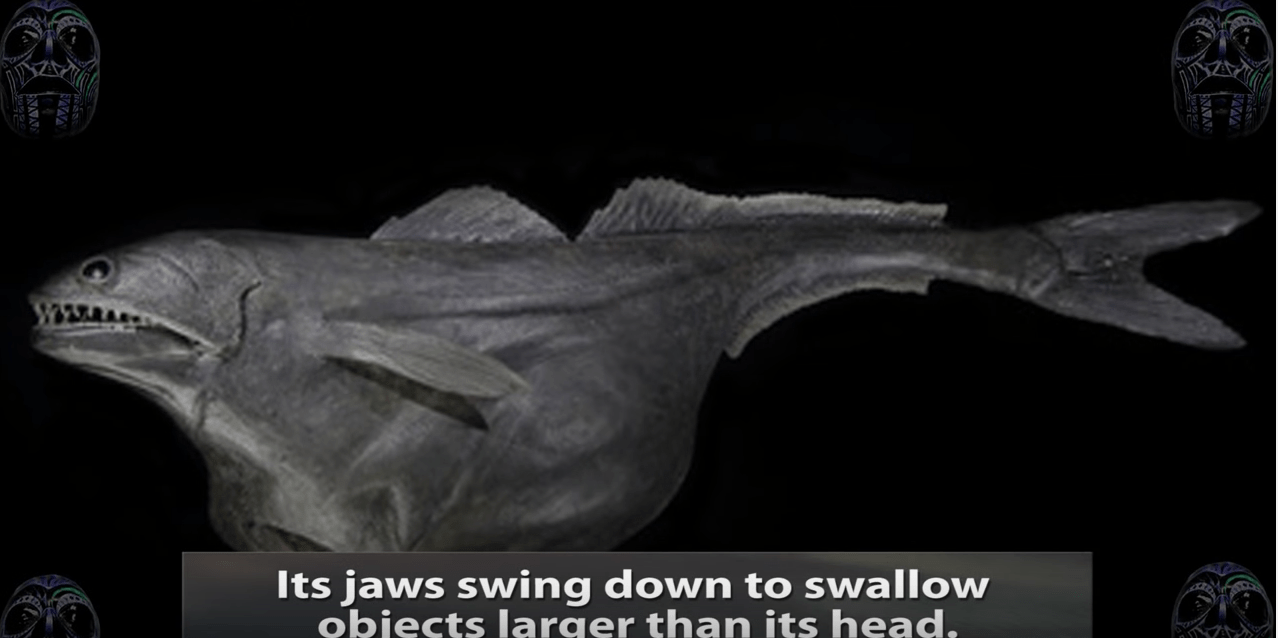
Screen Shot via YouTube
Scientific name: Chiasmodon niger
Habitat: This horrifying potbelly has been found in tropical and temperate waters of the Atlantic, Pacific and Indian Oceans, and can live as deep as 3000m below the surface.
Lifestyle: The black swallower is a predator, even though it’s kind of bad at being one.
Spooky fact(s): Because these monsters live so deep, food is scarce, so they often resort to eating creatures much larger than them. Sometimes, these geniuses eat things so big their stomach ruptures and they die in the least dignified way ever.
“This fish is able to swallow something bigger than itself because it has this elastic stomach that is able to open up and accommodate whatever it can get through its mouth,” Roberta Muehlheim, assistant curator of vertebrate zoology at the Cleveland Museum of Natural History told The Morning Journal.
In case you were wondering, here’s what death by your last meal looks like.
#greatscientificnames Chiasmodon niger (Black swallower….obviously the one doing the swallowing, not the swallowee) pic.twitter.com/Ll0CNs0onH
— THE Aquaman (@AquamanKyle) September 9, 2015
1) Frilled shark

Photo: Awashima Marine Park/Getty Images
Scientific name: Chlamydoselachus anguineus
Habitat: Sightings of the frilled shark are extremely rare, but they have been found off the coast of Australia. Of course they have.
Lifestyle: Predator. LOOK AT THAT THING AND TELL ME IT ISN’T.
Spooky fact(s): The frilled shark, which is referred to as a “living fossil” since it has changed so little over thousands of years, is basically a vacuum with teeth — 300 of them, to be exact. According to Bird, these teeth act like Velcro. “It’s got all those hook[ed teeth] in there… if you’re trying to catch a squid that’s gonna be slippery and moving fast, you need these Velcro-like teeth to come down and stop everything,” he explained. “As it grabs a fish or squid, [the prey] can’t escape.”
This nefarious garbage disposal has 25 rows of backward-facing teeth to eviscerate its prey, which really sounds like overkill — I feel like a few bites with these ridiculously sharp fangs would be sufficient, but hey, what do I know. If you’ve got it, flaunt it, I guess.
